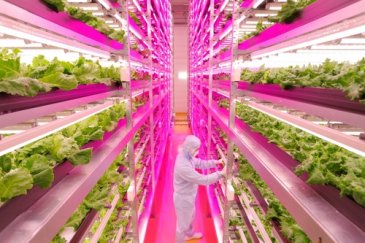This incredible indoor "food factory" in Japan is claiming that it can produce 100 times more heads of lettuce per day than an outdoor counterpart of the same area, and also produces 80 percent less food waste.
The entire thing is stored inside a building measuring around 2,500 square metres (25,000 square feet), and now versions of the set-up are being built in Hong Kong - with future construction planned in Russia, mainland China and Mongolia.
If that's not impressive enough, the farm, which is the largest in the world and housed in Japan's Miyagi prefecture - the site of the 2011 earthquake - also uses 99 percent less water than outdoor fields, according to Gloria Dickie from National Geographic.
The Mirai Group, the company behind the development, chose Miyagi for the site of their farm following the 2011 earthquake and tsunami, as there were food shortages in the region and concern over the safety of growing crops in the soil north of Fukushima. The building they chose for the project was an old, abandoned Sony factory, but the farm has now given it new life, as well as providing a local and sustainable supply of fresh food.
The entire thing is powered by 17,500 LED lights, specially designed for the project by GE Japan, which run at a wavelength that increases photosynthesis and cell division in the lettuce crops. And the scientists have also shortened the day and night length, as well as carefully controlled the humidity and temperature of the factory, in order to speed up the growth of the plants an unheard of two and a half times.
The incredible water savings come from the fact that, in outdoor farms, a lot of water is lost as it seeps through the soil and evaporates into the atmosphere. But the enclosed factory allows the water to be collected and recycled from the environment. And the lettuce crop itself is also more efficient - the plants don't have a core, which greatly reduces food waste.
Now Mirai is looking into expanding its vision.
"I believe that, at least technically, we can produce almost any kind of plant in a factory," plant physiologist and CEO of Mirai, Shigeharu Shimamura, told Gloria Dickie from National Geographic back in July 2014.
"But what makes most economic sense is to produce fast-growing vegetables that can be sent to the market quickly. That means leaf vegetables for us now. In the future, though, we would like to expand to a wider variety of produce," he added.
Their ultimate goal is to build more of the indoor farms around the world - particularly in regions where pollution, drought, flooding or climate stand in the way of food production - and use the water savings to help fuel complementary outdoor projects.
"Using this method, if we can build plant factories all over the world, we can support the food production to feed the entire world's population. This is what we are really aiming for," Shimamura told Dickie.
At the moment, half of the planting and harvesting process is regulated by manual workers, while half is done by robots - but in the future the company plans to automate the whole thing to make it even more efficient.
Although some people will undoubtedly dislike the idea of our vegetables essentially becoming industrialised, with up to 900 million people around the world currently suffering from starvation, it's an exciting and much-needed breakthrough that paves the way for the farms of the future.
Watch the GE Japan video below to find out more about the development of the farm.
Source: National Geographic, Web Urbanist
